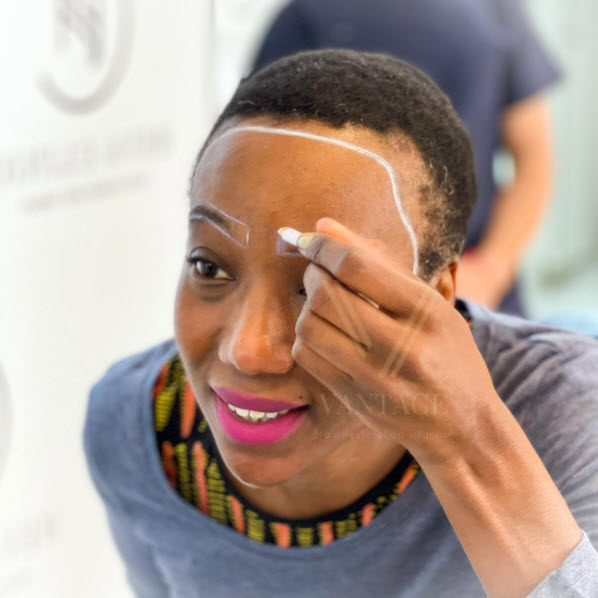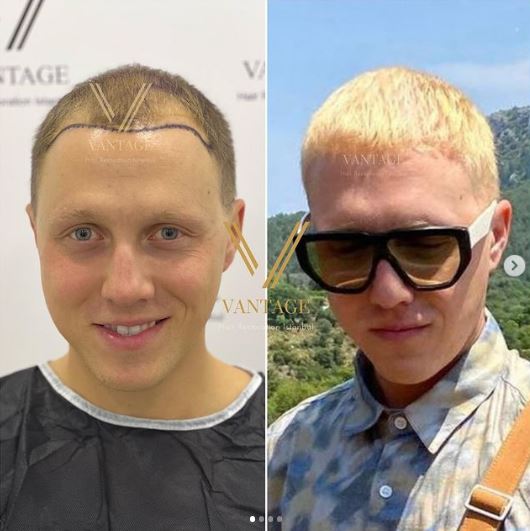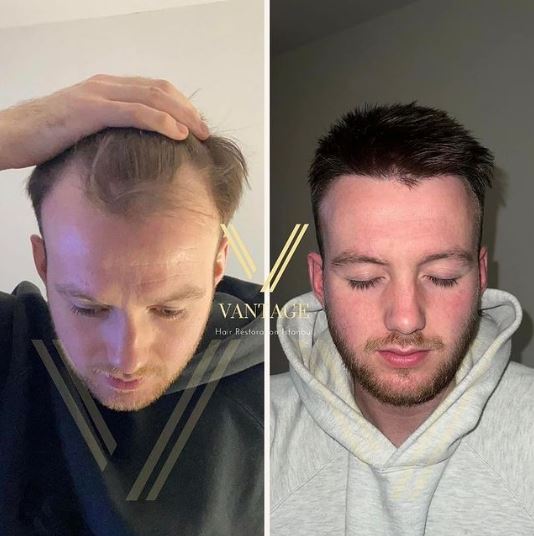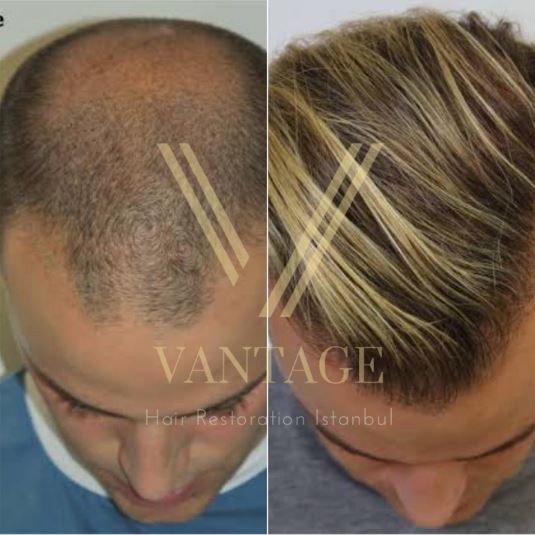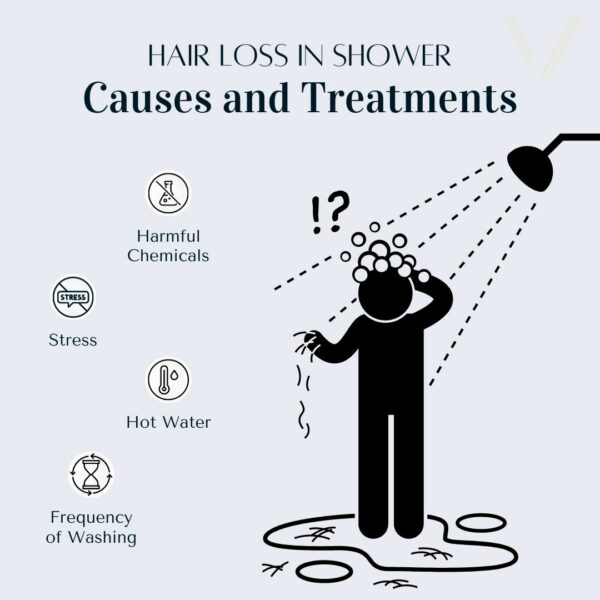
Hair loss in the shower can be a challenging issue to tackle. Seeing clumps of hair fall out every time you wash your hair can be a cause for concern. While it may not seem like a big deal initially, repetitive hair loss can lead to significant hair loss. Nobody wants to experience hair loss, but the good news is that there are ways to address it. Below, we’ll delve into the details of hair loss in shower, causes and treatments and how to address it accordingly.
How much hair loss is normal in the shower?

Did you know that on average, each individual loses up to 100-150 strands of hair every day? Hair follicles, like every living cell in our body, go through a growth cycle. This means that each hair strand grows and dies within its lifespan on this cycle. Therefore, losing 50 strands of hair in the shower can be considered normal. However, if you’re experiencing hair loss that exceeds this amount, please feel free to consult with our medical consultants to seek professional help.
What causes hair loss in shower?
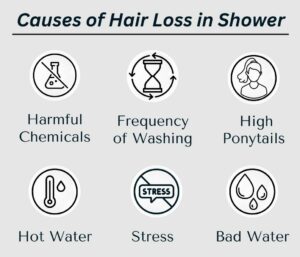
Trying out different hairstyles, such as high ponytails and braids, unconsciously pulling caused by stress, and applying too many hair products may cause you to lose a lot of hair. Additionally, the frequency of washing hair can also inhibit hair growth. Therefore, it’s crucial to consider these factors when evaluating the causes of hair loss in the shower.
Does taking a shower everyday cause hair loss?
Regular showering is beneficial for maintaining a healthy scalp and regulating the production of sebum. It also helps in removing dirt, dandruff, and other factors that may restrict hair growth. However, excessive showering may cause hair loss as it can lead to thinner hair follicles. While washing your hair frequently can help in removing oil buildup, it may cause dryness in some cases. Therefore, it is vital to maintain a balanced hair care routine that includes gentle cleansing and moisturizing to keep your scalp and hair healthy.
Can shower water cause hair loss?
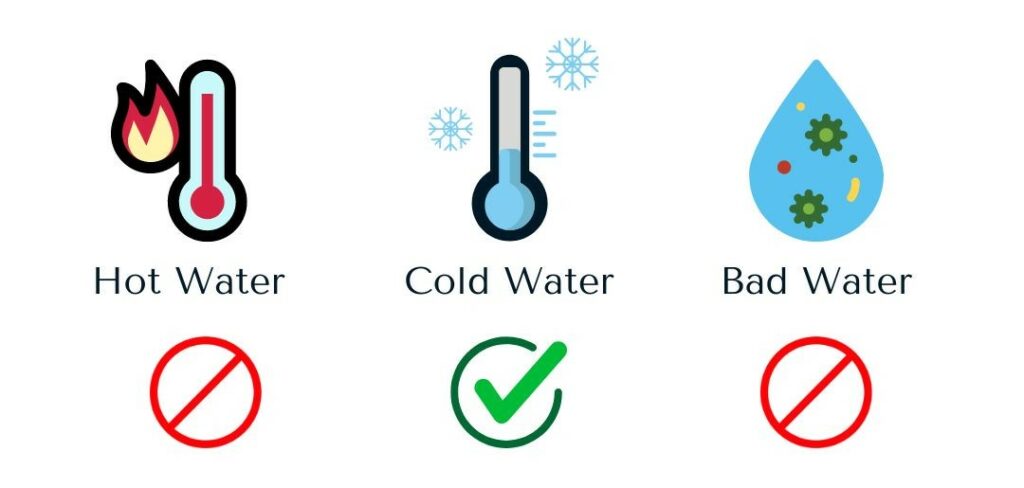
The quality of shower water is just as important as the frequency of showering, as it can greatly impact hair growth. Factors such as temperature, pH levels, and water hardness can all affect the quality of shower water and, in turn, the health of your hair. It’s worth noting that extremely cold and hot water can have distinctive effects on hair growth. Let’s take a closer look at these factors and how they can affect your hair:
Does a cold shower cause hair loss?
Taking a cold shower can have a refreshing and awakening effect on the body. The reason behind this is that the cold water stimulates an increase in blood flow and heart rate, resulting in a feeling of alertness and energy. Moreover, cold showering can also improve blood circulation on the scalp, which can potentially lead to strengthening of hair follicles. In fact, rinsing hair with cold water can help seal hair cuticles, leading to stronger strands that are less prone to breakage, ultimately resulting in fuller and healthier-looking hair.
Does a hot water shower cause hair loss?
Hot water is an effective way to relax and exfoliate the skin while also opening up the pores to remove excess dirt from the scalp. However, using excessively hot water for showers can have several adverse effects on your hair and scalp. Using extremely hot water for shower can:
- destroy healthy hair sebum,
- lead to hair breakage,
- dry out the scalp,
- inhibit hair growth
In extreme cases, using extremely hot water for a shower, which is boiling point hot, may even lead to burn scar alopecia, resulting in permanent hair loss. Therefore, it is essential to maintain an ideal temperature for your shower to prevent hair loss. The ideal temperature is lukewarm, as it enhancing a deeper cleansing by activating hair care products more efficiently, while also protecting your hair and scalp for optimal hair growth. [1]
Can bad shower water cause hair loss?
The quality of shower water is also as crucial as temperature for hair loss and scalp health. Bad shower water not only lowers the quality of your shower also may lead your hair to breakage. But what kind of water can be considered as “bad”? Bad water, or hard water, is a water that contains excessive amount of magnesium and calcium. Both of these minerals are found in our body and enhances bone density and skeletal growth; however, having these two minerals building up in hair, may not paint them in the best light to enhance hair growth.
Using hard shower water for long term cause a significant decrease in the strength and elasticity of hair follicles. [2, 3]
Bad water doesnt only imply hard water, it may also imply the the water has excessive amount of chlorine in it. You probably heard chlorine as a cleanser for pools, but chlorine is used for the purification of water in many different fields from pools, to shower water, and even for tap water. Chlorine in shower water directly affects hair shaft, which is a part of hair follicles that contains stem cells that promotes hair growth, and inhibits hair loss. [4]
How to stop hair loss in shower?
Hair loss in the shower is a common issue for many people. However, there are a few simple steps that can be taken to prevent this and even promote hair growth. The first and most important step is to use hair care products that contain clean ingredients. To do this, look for formulas that are free from harsh chemicals and sulfates, as these can strip the hair of its natural oils and cause dryness.
Another important step is to use a wide-tooth comb or detangling brush to gently remove knots and tangles from the hair. Begin by starting from the ends and working your way up to the roots. This helps prevent hair breakage and promotes healthy hair growth.
It’s also important to avoid washing your hair too frequently. Over-washing your hair can strip away natural oils and cause dryness, which can contribute to hair loss. Aim to wash your hair no more than 2-3 times per week, or as needed based on your hair type and lifestyle. This will help keep your hair healthy, strong, and shiny.
Does a shower filter stop hair loss?
Shower filters can be used to purify water and improve its quality while showering. By reducing the minerals that cause hair follicles to break, it paves the way for better hair health. Also, it enhances the level of exposure that the shower tap provides. However, it’s important to note that using a shower filter alone may not completely stop hair loss. Therefore, it’s essential to consider the underlying causes of hair loss.
What’s the most effective treatment for hair loss in shower?
Improving the quality of shower water, using hair care products with clean ingredients, and adopting hair-friendly hairstyles can slow down/ prevent hair loss. However, these are short term treatments and unfortunately they won’t be helpful if you have a patterned hair loss. But how to treat hair loss effectively? Let’s take a closer look at the most efficient methods for treating hair loss in shower, so you can tackle this issue head-on:
Hair Transplant
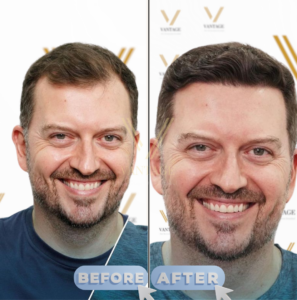
Out of all hair loss treatments available, hair transplant is the most efficient one. This is because it allows for achieving the desired density with minimal incision. Additionally, the success rate of hair transplant is higher than other hair loss treatments, as it involves using individual’s own hair grafts to treat hair loss.
Modern hair transplant techniques are known for their less invasive progress and seamless results. There are two popular methods in the world – FUE and DHI – both of which are based on the extraction of hair follicles individually.
When it comes to choosing the best method for you, the extent of hair loss, thickness texture, and the density of hair grafts are the key components to consider. So, feel free to contact to our medical consultants for the best hair transplant option for you and get hair loss out of your head.
PRP Hair Treatment

PRP is a treatment that can be used to enhance blood circulation in various areas of the body, from knees to scalp. When it comes to hair loss, PRP is an effective way to stimulate hair growth and improve the thickness and overall health of your hair.
The process for a PRP hair treatment is similar to other PRP applications. A small sample of your blood is taken, much like in a regular procedure. This sample is then placed in a centrifuge to separate the platelet-rich plasma from other components of the blood.
Once the plasma is separated, it is mixed with healthy vitamins and minerals and drawn into small syringes. The platelet-rich component is then injected into the scalp using a series of small needles. After the injections, a medical professional will gently massage the scalp to enhance blood circulation in the injected areas.
While PRP is an efficient way to treat hair loss, it’s important to note that multiple sessions are usually required to achieve noticeable results.
Hair Tattoo & Scalp Micropigmentation
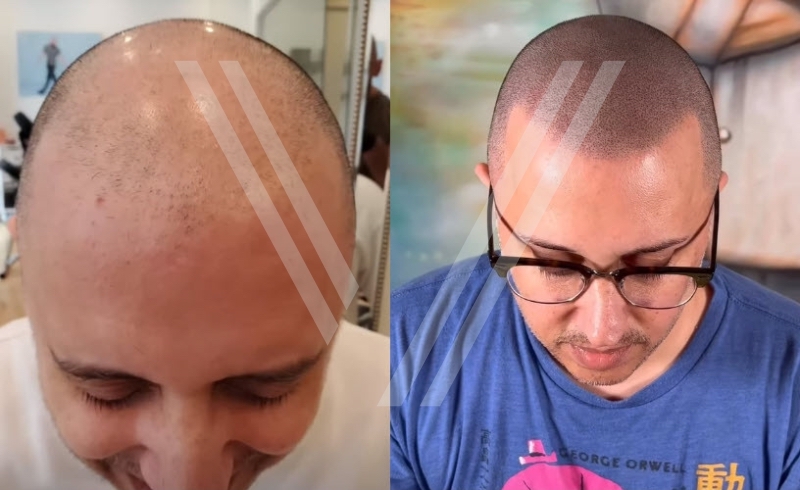
Scalp micropigmentation, also referred to as SMP, is a hair tattooing technique that utilises dot painting to create the appearance of hair follicles. This technique, known as hair pigmentation, is designed to enhance the appearance of hair by creating a fuller look, all without the need for a hair transplant procedures.
The pigment is carefully applied into the skin using a precise electric tattooing device and a fine needle. This needle is ideal for achieving precise and realistic results by creating small dots beneath the skin, mimicking the appearance of hair follicles. Typically, a variety of pigments in different shades are utilised to create a more authentic appearance.
While scalp micropigmentation is generally seen as a positive choice, it’s important to be aware of potential drawbacks as well. The outcome of scalp micropigmentation is greatly influenced by the expertise of the surgeon performing the procedure.
Medications
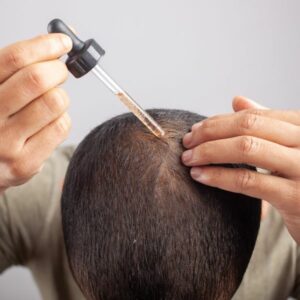
Hair loss medications are one of the ways that can help to slow down hair loss or control the underlying causes. However, it’s important to remember that these medications, when taken for a long period, can cause serious side effects. Therefore, it’s important to consult with a healthcare professional before starting any medication for hair loss and to monitor any changes while taking them.
Minoxidil
Minoxidil is a topical drug approved by the FDA, which is primarily used to slow down hair loss. It was originally developed to treat high blood pressure due to its vasodilator effect, which enhances blood vessel dilation and promotes blood circulation. However, it has also shown successful results in combating hair loss when used regularly.
It is important to note that Minoxidil is not a permanent solution for hair loss. In addition, it is recommended to use diluted versions of the medication and take breaks during long-term use to reduce the likelihood of experiencing potential side effects. Furthermore, you should avoid using Minoxidil without the supervision of a healthcare professional.
Finasteride
Finasteride is a medication that’s been approved by the FDA to help slow down hair loss. Unlike Minoxidil, Finasteride is usually taken orally. It works by acting as a 5-alpha reductase inhibitor, which helps to prevent the conversion of testosterone to dihydrotestosterone. Dihydrotestosterone is the primary cause of androgenetic alopecia. However, since
Finasteride directly affects hormone balances, it’s important to use it with utmost care and monitoring. It’s also important to avoid using Finasteride to prevent potential side effects. Some of the serious side effects associated with Finasteride include:
- sexual dysfunction
- gynecomastia
- allergies
- depression
FAQs About Hair Loss in Shower
Is hair loss after shower normal?
It is entirely normal to experience hair loss after showering, and the amount of hair that falls out can vary. Shedding hair is part of the natural hair growth cycle, where hair follicles go through different stages of growth, transition, and rest. During the resting phase, old hairs naturally shed to allow new hair growth, and this shedding is a natural occurrence in the hair follicle conversion process. Typically, shedding does not result in noticeable hair thinning or balding, making it a completely natural and expected process.
How much hair loss is normal after shower?
Each individual loses up to 100-150 hair strands every day. While it may not be noticeable throughout the day, it may become more visible as you interact with your hair more, such as when you shower. So, if you’ve been noticing a few strands of hair falling out and it’s been tangling you, don’t worry, it’s quite normal!
Can shower caps cause hair loss?
Shower caps are a handy accessory that can help protect your hair from frizzing and losing its natural moisture after showering. They are usually made from a breathable fabric that allows your hair to breathe and prevent the buildup of humidity.
It’s important to note that using a shower cap does not directly cause hair loss. In fact, using a good shower cap while sleeping can actually help prevent hair follicles from becoming brittle and enhance scalp health.
Using a shower cap that is too tight or dirty may lead to hair loss. Therefore, it’s crucial to choose a shower cap that fits comfortably without being too tight and to avoid wearing it for extended periods, particularly if it’s warm or damp inside.
Can a moldy shower head cause hair loss?
Mold is a common allergen that can negatively impact the scalp and hair. When present in these areas, it can lead to an unexpected allergic reaction which causes excessive hair shedding, and weakens the hair shaft and roots.
Did you know that mold and mildew can grow in your shower head? It’s true! And when you take a shower, the particles and spores from the mold and mildew can mix with the water stream. These particles can come into contact with your scalp, which can cause irritation or allergic reactions. If the irritation persists, it can lead to inflammation and disrupt the hair growth cycle, ultimately resulting in hair loss.
To avoid the growth of mold and mildew in your shower head and the resulting hair loss and scalp infections, it’s important to regularly change your shower head. By doing so, you can keep your scalp healthy, your hair growing, and your showers refreshing!
What blood test shows hair loss?
While blood tests themselves may not directly identify hair loss, abnormal levels of certain values could indicate hair loss. These are such:
- Thyroid hormone levels: When the thyroid gland is either overactive or underactive, it can affect the body’s metabolism, which in turn can lead to hair loss. Indicators of thyroid functions in blood tests are TSH, FT4, and FT3. These indicators can help to identify whether the thyroid gland is functioning normally or not
- Sex hormones: Both men and women produce testosterone, which metabolizes into DHT. When DHT binds to androgen receptors in hair follicles, it causes them to shrink and stop producing hair. The levels of various sex hormones in the blood can be detected through indicators such as FSH, LTH, Testosterone, and Prolactin.
- CBC: Red blood cell, white blood cell, and platelet counts can all be found out using a complete blood count (CBC). A low red blood cell count, or anaemia, is one factor that can lead to hair loss.
- Iron and ferritin capacity: Hair loss can be caused by low iron levels or iron-deficiency anaemia. Tests like serum iron, ferritin, and total iron-binding capacity (TIBC) can be used to assess iron levels.
- Infection markers (CRP, ESR,etc): Elevated levels of CRP, or C-reactive protein, in the body may suggest the presence of inflammation. Inflammation can sometimes be linked to certain types of hair loss, such as alopecia areata.
In cases of autoimmune-related hair loss, like alopecia areata or lupus-related hair loss, specific tests for autoantibodies may be necessary to arrive at a diagnosis. These tests can help identify the presence of specific antibodies that may indicate an autoimmune response causing the hair loss.
References
- https://www.gloshospitals.nhs.uk/media/documents/Good_hair_care_advice_GHPI1694_01_22.pdf
- Luqman, Muhammad Waqas; Ramzan, Muhammad Haris1; Javaid, Usama2; Ali, Roshan3; Shoaib, Muhammad4; Luqman, Muhammad Ayyas5. To Evaluate and Compare Changes in Baseline Strength of Hairs after Treating them with Deionized Water and Hard Water and its Role in Hair Breakage. International Journal of Trichology 10(3):p 113-117, May–Jun 2018. | DOI: 10.4103/ijt.ijt_115_16 https://journals.lww.com/ijot/fulltext/2018/10030/to_evaluate_and_compare_changes_in_baseline.4.aspx
- Srinivasan, Gautham; Srinivas, Chakravarthi Rangachari; Mathew, Anil C; Duraiswami, Divakar. Effects of Hard Water on Hair. International Journal of Trichology 5(3):p 137-139, Jul–Sep 2013. | DOI: 10.4103/0974-7753.125609 https://journals.lww.com/ijot/fulltext/2013/05030/Effects_of_Hard_Water_on_Hair.8.aspx
- Du, W., Dong, Y., Wang, Z., Yao, S., Wang, M., Ji, J., … & Quan, R. (2022). Study on the mechanism of cadmium chloride pollution accelerating skin tissue metabolism disorder, aging and inhibiting hair regeneration. Frontiers in Public Health, 10, 1035301. https://www.frontiersin.org/journals/public-health/articles/10.3389/fpubh.2022.1035301/full
Article Review By: Dr. Jyothi Shenoy V
Profile Link
MBBS, MD – Obstetrics & Gynaecology, MRCOG(UK)
23 Years Experience Overall


